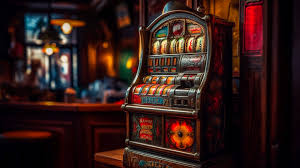
Slot machines have come a long way since their humble beginnings as mechanical “one-armed bandits.” Today, they are an integral part of casinos worldwide, both land-based and online, providing millions with entertainment and the chance to win big. But how did this iconic game evolve from a simple lever-operated device to the sophisticated digital apps we enjoy today? In this blog, we’ll take a journey through the history of slot machines, from their creation to the modern-day innovations that have transformed the gaming landscape.
The Birth of the Slot Machine: The One-Armed Bandit
The origins of the slot machine can be traced back to 1891, when the first gambling machine was invented by Sittman and Pitt, two Brooklyn-based entrepreneurs. Their machine, though rudimentary, resembled what we know as a slot today. It featured five drums with card faces and was designed to work like a poker game. Players inserted a coin and pulled a lever to spin the drums, hoping to land a winning combination of cards. However, this early machine didn’t have a payout mechanism, meaning that winnings were often determined by the bar owners themselves.
It wasn’t until 1895 that the first true slot machine—complete with a payout mechanism—was invented by Charles Fey. Fey’s “Liberty Bell” machine used three reels and featured symbols like horseshoes, diamonds, spades, and the iconic Liberty Bell. When the bell symbol lined up, it paid out the jackpot—50 cents, a small fortune at the time.
Fey’s invention became immensely popular, but it also faced challenges. Gambling was illegal in many places, so many slot machines were banned or pushed underground. Despite this, the machine became synonymous with the word “casino,” and slot machines began to spread throughout the country.
The Rise of Mechanical Slot Machines
In the early 20th century, slot machines grew in popularity, and so did the innovation behind them. During the 1930s, slot machines began to appear in casinos, though they were still mechanical devices operated by a lever—hence the term “one-armed bandit.” These machines often featured symbols like fruits, bells, and lucky sevens, and became known for their bright, eye-catching designs.
One of the biggest advancements in the 1960s was the introduction of electronic slot machines. These machines included electrical components that made the spinning process smoother, increased reliability, and allowed for more complex payout structures. The introduction of video slots, which displayed spinning reels on a screen rather than physical wheels, was another milestone that revolutionized the gaming world.
The Digital Revolution: Video Slots and Online Casinos
The 1990s marked a major turning point in the history of slot machines with the rise of video slots. These machines allowed for more creative themes, bonus rounds, and multi-line pay systems, taking the gaming experience to the next level. Video slots also made it possible to design slots with themes that appealed to a broader audience, from classic fruit machines to slots based on movies, TV shows, and pop culture.
But the biggest transformation came with the internet boom. As online casinos began to gain traction in the late 1990s and early 2000s, slots were one of the first games to migrate to the virtual world. Online slot machines gave players the convenience of playing from home, with a wider variety of themes and game mechanics than traditional brick-and-mortar casinos could offer. Unlike the limited number of physical slot machines in casinos, online platforms offered players hundreds, if not thousands, of options.
Mobile Slots and Apps: Gaming on the Go
The latest evolution in the history of slot machines has been the shift to mobile gaming. With the advent of smartphones and tablets, online casinos soon introduced mobile apps that allowed players to access their favorite slot machines anywhere, anytime. Mobile slots are built with user-friendly interfaces, quick loading times, and responsive designs, ensuring that the experience on a smaller screen is as immersive as it is on a desktop computer.
Many mobile slot apps now feature a range of exciting features, such as progressive jackpots, 3D graphics, and interactive bonus rounds, creating a highly engaging experience for players. The ability to play slots on the go, combined with ever-evolving graphics and gameplay mechanics, has led to a massive surge in mobile gaming.
The Future of Slot Machines: Innovation Continues
As technology continues to advance, the future of slot machines looks brighter than ever. Virtual Reality (VR) and Augmented Reality (AR) are beginning to make their way into the casino industry, offering players a more immersive experience. Imagine stepping into a virtual casino where you can interact with other players and spin the reels of your favorite slot machines in a completely digital world.
Additionally, blockchain technology and cryptocurrency are expected to play an increasingly important role in online casinos, providing players with secure, fast, and anonymous ways to bet and win. This could further expand the accessibility of slot machines for players around the world.
Conclusion
From the early days of the Liberty Bell to the modern mobile apps we use today, slot machines have undergone an incredible transformation. The simplicity of the first mechanical machines has given way to digital innovations that keep players engaged with stunning graphics, intricate bonus rounds, and the convenience of playing from anywhere.
As the gaming industry continues to evolve, it’s clear that slot machines will remain a central part of the casino experience—whether they’re in a land-based casino, on your smartphone, or in a virtual reality environment. For now, players can continue to enjoy the exciting world of slots, knowing that the future of the game will only get more thrilling.
